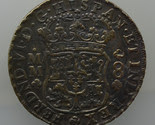1754 Mexico Ferdnd VI, 8 reales, Spanish Colonial
Silver DOS MUNDOS or PILLAR COINAGE
This is a highly collectible eight reales of 1754, mint, pillar type, ("different crowns") royal crown and imperial crown (1754. México. MM. 8 reales. Columnario. real - corona imperial.) This date marks the transition between "crowns alike" and "different crowns" (this coin specimen). Very rare, very fine "DOS MUNDOS or PILLAR Spanish Colonial COINAGE".
OVERVIEW:
M 'o' on top' (Mexico) - the origin or mint where the coin was struck
'1754' - the year of mintage
'MM' - assayer's initial
'8' - denomination of the coins
'Ferdnd VI' - the ruling monarch
These beautiful silver coins proclaimed by their bold design Spanish dominion over the Old World of Europe and the New World of the Americas and the East. They steadily came to replace the much abused cob coins through the medium of a prescribed circular shape sealed against debasement by a distinctive milled floral edge.
These coins were the famous "pieces of eight" (referring to the 8-real coin) of legend and literature. Exquisitely designed, and strictly of 916.66 fine silver, these columnarias were minted with screw presses in the same denominations as the earlier cobs and immediately established the well earned reputation of being the best known and respected coins in every part of the known world, making them the prototype of modern international currency..
Design
The 8 Reales represented the largest denomination for the Pillar coinage series. These crown-size coins were approximately 37 to 41 millimeters in diameter and weighed around 417.6 grains (27 grams). It carried a silver fineness of .916. This fineness was a little devaluation from the old .930 carried by the old cobs. This 'devaluation' was possibly made to offset the increased cost in the manufacture of these coins.
OBVERSE:
OBVERSE:
the crowned Pillars of Hercules and the crowned hemispheres of the Old and New World floating on the sea
legend PLUS ULTRA, which means "further beyond", on the scroll the twines on the pillars
depicted the Spanish colonial domination of both Old and New World with the latin inscription -- "VTRAQUE VNUM", meaning the union of two worlds.
REVERSE:
the crowned Coat of Arms of Spain, along with the Latin legend "FERDND-VI-D-G-HISPAN-ET- IND-REX" (Ferdinand VI - By the grace of God; King of Spain and the Indies.)
When Charles I (1516-1556), the first Hapsburg monarch, sailed for Spain from Netherlands to claim and sit on the throne left vacant by his grandfather, Ferdinand the Catholic, a group of forty ships accompanied him. On his flagship, it carried a picture of the Pillars of Hercules with scrolls that twines around the pillars. The scroll bore the young monarch's motto - Plus Ultra.
The origin of the pillars and "PLUS ULTRA" are traced to the legendary Greek hero, Hercules, where on his journey to capture a 3-bodied monster on the island of Erythia, he erected two pillars on the sides of the Straights of Gibraltar between Europe and Africa. During those time, it was thought to mark the edge of the world, hence in latin -- "Ne Plus Ultra" (Nothing lies further).
Charles I removed the word "Ne" and carried "Plus Ultra" as his motto in his ambition to expand the Spanish Empire beyond its European possessions during that period. Note that Magellan discovered the Americas during those period.
It was ironic though that it was in the period of this coinage that Spain lost its luster as a world superpower and began to loose grip of its colonies.
When Charles I (1516-1556), the first Hapsburg monarch, sailed for Spain from Netherlands to claim and sit on the throne left vacant by his grandfather, Ferdinand the Catholic, a group of forty ships accompanied him. On his flagship, it carried a picture of the Pillars of Hercules with scrolls that twines around the pillars. The scroll bore the young monarch's motto - Plus Ultra.
The origin of the pillars and "PLUS ULTRA" are traced to the legendary Greek hero, Hercules, where on his journey to capture a 3-bodied monster on the island of Erythia, he erected two pillars on the sides of the Straights of Gibraltar between Europe and Africa. During those time, it was thought to mark the edge of the world, hence in latin -- "Ne Plus Ultra" (Nothing lies further).
Charles I removed the word "Ne" and carried "Plus Ultra" as his motto in his ambition to expand the Spanish Empire beyond its European possessions during that period. Note that Magellan discovered the Americas during those period.
It was ironic though that it was in the period of this coinage that Spain lost its luster as a world superpower and began to loose grip of its colonies.
CONDITION:
Light wear; very clear details. This is the actual coin that you will get.


Hey you got it all wrong.
ReplyDeleteThe very rare coin is the one with the Crowns alike, the 2 Imperial Crowns.